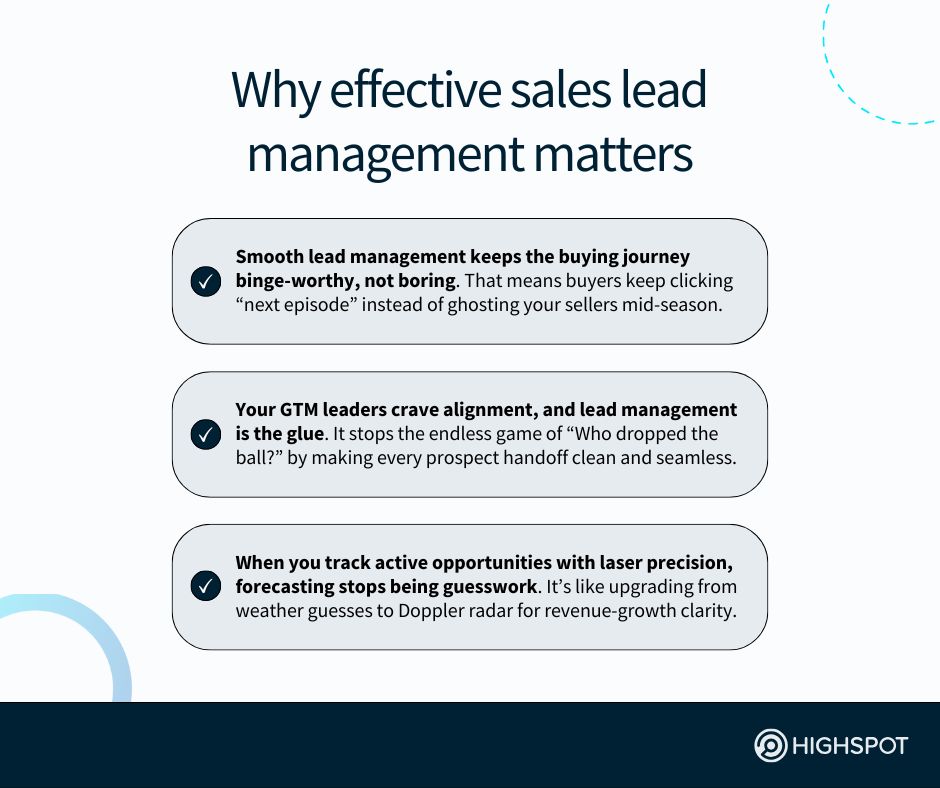Key Takeaways
- Lead management is about creating order from chaos, not juggling spreadsheets. When you identify, qualify, nurture, engage, and convert with intent, reps stop wasting energy chasing bad fits and start building momentum that drives predictable pipeline growth.
- Sales lead management is the lifeblood of your sales process, keeping opportunities flowing instead of stalling. Sellers win more when every handoff is seamless, every touchpoint is intentional, and reps spend their energy on conversations that actually close.
- The right lead management software and strategy doesn’t just help you manage—it helps you multiply. By enabling reps and sellers to qualify smarter, nurture stronger, and engage earlier, you equip your team to convert leads into loyal customers at scale.
Sales professionals such as yourself have all felt the frustration of a pipeline that looks full but, in reality, is packed with leads that aren’t going anywhere.
- Marketing insists its brand-awareness and demand-generation campaigns delivered plenty of potential customers, in the form of net-new MQLs.
- Sales reps counter that most of those names aren’t sales-ready leads (or simply don’t closely align with the company’s ideal customer profile).
Revenue operations usually steps in with reports on lead behavior to get to the bottom of pipeline generation activities, but the core problem remains: Companies rarely agree on what a qualified lead is (or who even gets to make that call).
Without agreement, the sales process stalls, and the sales funnel gets messy.
That’s why a structured sales lead management process is so important today.

What is sales lead management?
Lead management is the process of identifying, capturing, qualifying and nurturing prospects through the sales pipeline until the completion of a deal cycle, either by converting into a new customer or being archived in one’s CRM system.
The lead management process involves capturing potential buyers’ interest, scoring those leads based on their activity as they move through the sales funnel, routing them to the right rep, and tracking engagement with them over time.
In your overall sales process, managing leads is like managing time: If you don’t control it, it controls you. That’s why many B2B sales teams use a combination of their CRM and sales prospecting tools as their effective lead management systems.
But when sales operations scale, using those tools alone fall short.
Think about it: Your sales reps are constantly juggling prospects.
- If your lead management system isn’t airtight, your pipeline leaks faster than a cheap faucet, and your BDRs’ collective closed-won rate declines.
- If you have a highly effective lead management approach—and best-in-class tools that offer AI for sales teams like yours—sellers can easily (and quickly) use every spoken, shown, and shared signal to inform next-best actions, ensuring they connect with potential customers at the right places and times.
Your reps spend less time guessing and more time nurturing leads.
Why an effective lead management is essential to sales and GTM success
Highspot’s State of Sales Enablement Report 2025 found 47% of enterprise go-to-market teams struggle to deliver a strong customer experience for leads, while 41% find it challenging to provide timely and personalized engagement.
The root cause behind these issues? An inadequate lead management system.
Without an effective lead management strategy, predictable problems emerge:
- Sellers spend too much time pursuing the wrong prospects, which causes deal cycles to extend because the wrong individuals are in the funnel.
- The lack of a dedicated, structured customer relationship management approach leads to fragmented and, often, off-message buyer engagement.
- Instead of collaborating closely with one another on business-critical go-to-market initiatives, like product launches, sales and marketing teams argue over SLAs.
- Because the underlying lead data behind their approach is inaccurate and not properly disseminated across GTM tools, sales forecasting become unreliable.
With the right system, though, these challenges disappear. You realize:
- Faster lead conversion and more closed deals: Zero in on the right opportunities, and stop wasting time chasing dead-end accounts that won’t convert (or, at the very least, won’t lead to a sizable annual contract value).
- A smoother customer journey: Your prospects glide through their B2B buying journey without frustrating snags, stalls, or awkward handoffs from marketing.
- Stronger sales and marketing alignment: Shared MQL and SQL definitions keep everyone in go-to-market in sync and kill the endless, inefficient blame game.
- Cleaner lead tracking: Reliable lead data sharpens sales forecasting and gives your GTM leaders a clear view of lead activity that drives smart decisions.
Most lead management systems promise simplicity. Too often, though, they create complexity instead of clarity when it comes to aligning people, processes, and priorities.
A modern lead management strategy streamlines the buying process, keeping momentum high while eliminating the clunky friction that slows everything down.
The end result of this upgraded approach is a more impactful sales strategy that moves the needle (read: leads to greater, more predictable revenue growth).
When you can consistently track lead activities and get a real-time view of lead behavior, you unlock valuable insights you can use to double down on what’s working, as it pertains to how your sellers ID and engage potential leads.
| Sales lead management FAQs | Answers |
|---|---|
| Why is lead management important for scaling predictable revenue growth today? | Lead management keeps your pipeline organized, ensuring no opportunity slips through the cracks or stalls. By prioritizing and nurturing leads, you accelerate conversions and empower reps to focus energy on the deals most likely to close. |
| How can I manage leads effectively across multiple channels and buyer touchpoints? | Use your CRM, marketing automation, and sales enablement tools to manage leads efficiently. Integrated together, these solutions centralize data, automate tasks, and give reps real-time visibility into buyer interactions, helping drive smarter customer engagement. |
| What are the biggest challenges GTM teams face when trying to manage leads at scale? | Common challenges include fragmented data, inconsistent qualification standards, and bloated tech stacks that slow teams. Without clear workflows, reps waste time on admin, lose focus on selling, and damage credibility with buyers expecting fast, frictionless interactions. |
| How does lead management influence deal velocity in high-pressure B2B sales cycles? | Sales lead management reduces lag between buyer signals and rep action, speeding responses. By routing leads faster and surfacing real-time insights, reps act quickly, cut friction, and move deals forward at the pace today’s buyers expect and demand. |
| Can lead management help me forecast pipeline and revenue more accurately? | Accurate lead tracking creates clean data that feeds forecasting models with confidence. Go-to-market leaders can predict outcomes, spot risks earlier, and design revenue plans based on facts, not instinct, leading to a stronger GTM strategy and enabling faster pivots. |
| How can I ensure my lead management tools don’t overload my sales technology stack? | Evaluate tools that integrate with your CRM and empower each sales rep without adding administrative chaos. Focus on scalability, automation, and actionable analytics that reveal which activities create real revenue impact rather than just report activity volume. |
5 stages of the lead management process
The lead management process provides structure so potential customers have a consistent experience and you realize your desired return on investment.
Here’s how the stages break down:
1. Lead generation: Capturing net-new contacts
Lead generation (a.k.a. lead acquisition) ensures a steady stream of net-new prospects are added to the funnel for the sales team to eventually engage, provided their lead scores reach a certain threshold in time. (More on this shortly.)
Marketing acquires leads through campaigns with landing page forms, events, and targeted content marketing, while sales teams proactively reach out to potential customers through a LinkedIn social selling approach.
The goal is simple: Capture leads who match your ideal customer profile (ICP).
2. Lead qualification: Turning prospects into SQLs
Disagreements between sales and marketing often arise around what qualifies as a strong lead. To resolve this, companies distinguish them as a:
- Marketing-qualified lead: A lead that has shown interest through actions like downloading a whitepaper, signing up for a webinar, or visiting pricing pages.
- Sales qualified lead: A lead that shows intent, fits ICP criteria, and passes common frameworks like BANT (Budget, Authority, Need, Timing) or MEDDIC.
- Sales-accepted lead: This is often a middle step: Marketing passes a lead to sales, which then confirms acceptance before pursuing further qualification.
Before moving a prospect forward, it helps to evaluate them against your agreed-upon standards. To gather this qualification information, go-to-market teams often rely on lead scoring (assigning points for behaviors and demographics) and discovery calls to confirm pain points, budget, and timeline.
Most GTM teams at B2B organizations also segment leads by industry, company size, lifecycle stage, behavioral signals, and geography, among other traits.
3. Lead distribution: Assigning the right sales reps
Once leads are qualified, they should be routed to the right rep quickly. The faster a sales rep receives a warm lead, the more likely it is to convert.
For ‘hot’ leads with high scores, specifically, managers may even call a quick briefing with the assigned rep, or the full team, to set follow-up priorities.
Standard lead distribution methods include:
- Round robin: Distribute leads evenly across reps to maintain balance.
- Territory-based: Route by region, ensuring reps focus on local accounts. For example, a manufacturing lead from Chicago routes to the Midwest territory rep.
- Rule-based: Assign based on product line, company size, or potential deal value. For example, a small SaaS prospect might go to an inside sales team, while a Fortune 500 company is automatically routed to enterprise field reps.
A strong lead-distribution and -routing approach gets the right opportunities to the right reps faster, boosting speed-to-response, buyer trust, and win potential.
4. Lead nurturing: Keeping warm leads engaged
Not every lead is ready to buy immediately. In fact, the majority need weeks (or months) to research vendors, as their procurement processes are complex.
This makes nurturing quality leads essential.
Lead nurturing includes manually connecting with prospects across various touchpoints and setting up automated sales follow-up emails with engaged buyers. These emails can feature links to case studies, white papers, thought-leadership pieces, and other collateral.
Ideally, though, reps include links to digital sales rooms—like ones reps with Highspot use to create and send to prospects so they have a shared online location to access deal-related materials throughout the entire sales cycle.
5. Lead conversion: Closing deals with buyers
Conversion is where the whole process—lead capture, qualification, distribution, and nurturing—pays off. Your sales analytics show where prospective customers become paying customers, and which parts of the sales process worked.
But conversion is not the end.
These customers now need ongoing education and guidance to build loyalty, grow their lifetime value, and prevent churn. You can continue engagement with onboarding content, training resources, and regular ‘how are you doing’ check-ins.
In other words? Collecting leads and scoring leads are pivotal parts of the lead management process—but having your sales team seamlessly hand off closed-won accounts to customer success to take the reins is critical to business growth.
Best practices for lead management
There are many tried-and-true best practices for lead management—important ones that dictate your organization’s ability to close new business consistently (not to mention keep pace with core competitors in your space).
Here are a handful of best practices worth abiding by closely.
Learn what your sales cycle looks like
Mapping the B2B sales cycle helps identify where deals slow down.
Your cycle might start with an initial contact from a webinar signup, move to a quick discovery call, then a product demo, a round or two of proposals and negotiations, and finally a signed contract and onboarding.
If most leads stall after demos, for example, sales managers know to dig into that process.
Align enablement, sales, and marketing teams
Teams must align on everything that impacts lead generation, including the quality of lead information. Gartner reports that 47% of companies say their lead generation suffers because sales and marketing are misaligned.
To fix this, your GTM teams need shared definitions and to collaborate closely.
Ways to build alignment include:
- Joint workshops: Marketing, sales, and RevOps meet to agree on the ideal customer profile, buyer persona definitions, and qualification criteria.
- Shared sales dashboards: Real-time views of marketing engagement data and sales outcomes keep both sides informed and accountable.
- MQL/SQL definition agreement: An MQL could be someone who engaged with a product webinar (attended or watch on-demand) and matches the ICP. Meanwhile, an SQL could be a lead who confirmed purchase authority and timeline on a discovery call.
- CRM and marketing automation integration: Connect marketing automation platforms with the CRM so that lead activity, including downloads, page visits, and email opens, are visible to marketing and sales for faster, more valuable follow-ups.
Revenue operations often serves as the neutral facilitator, ensuring decisions are documented, enforced, and updated as the market or product strategy evolves.
Centralize and clean all your customer data
Messy lead data is known to slow down sales reps. Update records, remove duplicates, and make sure all lead activities are tracked. You need this data for:
- Forecasting: This relies on accurate sales pipeline numbers to ensure you can easily anticipate the likely number of closed deals in a given timeframe.
- Personalization: This necessitates current job titles, industries, and engagement history to use your marketing automation software to engage leads.
- Lead scoring: This requires having precise behavioral data so that your go-to-market function can easily score leads based on their level of engagement.
Of all the best practices listed here, having accurate, up-to-date, unified data in a central location—ideally, your CRM and sales enablement platform—your reps’ sales efforts will help move the needle and they won’t waste their time.
Just remember: If your pipeline stages do not accurately reflect what actually happens in deals, reporting becomes useless. Sync your CRM to real sales activities like discovery calls, demos, proposals, and sales negotiations.
Set the tone for every single sales interaction
Pre-framing interactions keeps conversations clear and establishes the relationship on a foundation of trust. For example: “I’ll walk you through how others in your industry are solving this problem. By the end, you’ll know whether a demo is the right next step.”
This format also sets clear expectations and helps the buyer feel more at ease.
Also, remember that leads expect your outreach (and often, to show you care about their business). The trick is to add value instead of “just checking in.” Share relevant articles, quick insights, or a short success story to nurture leads without pushing too hard.
Recent research from McKinsey shows that when companies automate follow-ups with personalization and rapid response, their sales teams’ conversion rates climb by about 25%.
Turning buyers into loyal customers with the right lead management tools
Sales lead management ensures that leads are handled with purpose, structure, and speed.
Your go-to-market leadership team defines the rules and expectations, marketing and sales teams align on execution, and cutting-edge technology makes it possible.
Even if you start with a small improvement, such as cleaner data, refined qualification criteria, or improved follow-up, you’ll transform how leads move through your sales funnel.
The result is a healthier pipeline, more renewal opportunities, and a steady stream of warm leads for your reps to research, engage, and gradually advance in the sales cycle.




